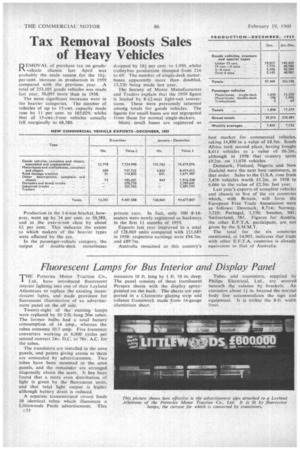Tax Removal Boosts Sales• of Heavy Vehicles
Page 60

If you've noticed an error in this article please click here to report it so we can fix it.
ypo EMOVAL of purchase tax on goods.1.‘ vehicle chassis last April was probably the main reason for the l6per-cent. increase in production in 1959 compared with the previous year. A total of 353,105 goods vehicles was made last year, 50,095 more than in 1958.
The most significant increases were in the heavier categories. The number of vehicles of up to 15-cwt. capacity made. rose by 11 per cent. to 185,029, whilst that of 157ewt.-3-ton vehicles actually fell marginally to 68,580.
dropped by 181. per cent. to 1,990, whilst trolleybus production slumped from 216 to 69. The number of single-deck motorbuses apparently more than doubled, 15,320 being made last year.
The Society of Motor Manufacturers and Traders explain that the 1959 figure is loaded by 8-12-scat light-van conversions. These were previously returned among totals for goods vehicles. The figures for small buses are not segregated from those for normal single-deckers.
Many small buses are registered as Production in the 3-6-ton bracket, however, went up by 34 per cent. to 50,589, and in the over-6-ton class by about 62 per cent. This indicates the extent to which makers of the heavier types were affected by the tax.
In the passenger-vehicle category, the output of double-deck motorbuses private cars. In fact, only 500 8-14seaters were newly registered as hackneys in the first 11 months of 1959.
Exports last year improved to a total of 128,069 units compared with 121,685 in 1958: respective earnings were £94.7m. and £89.7m.
Australia remained as this country's best market for commercial vehicles, taking 14,890 to a value of £8.5m. South Africa took second place, having bought 8,611 vehicles . to a value of 16.2m., although in 1958that country spent £9,2m. on 11,076 vehicles.
Denmark, Finland, Nigeria and New Zealand were the next best customers, in that order. .Sales to the U.S.A. rose from 3,436 vehicles worth it2rn. in 1958 to 6,066 to the value of £2.3m. last year.
Last year's exports of complete vehicles and chassis t6 'five of the six countries which, with Britain, will form the European Free Trade Association were as 'follows: . Denmark, 8,714; • Norway. 3,219: Portugal, 1,350; Sweden, 941; Switzerland, 581. Figures for Austria, the other E.F.T.A. participant, are not given by the S.TVI.M.T.
The total for the six countries mentioned, at 14,905, indicates that trade with other E.F.T.A. countries is already equivalent to that of Australia.. •








































































































